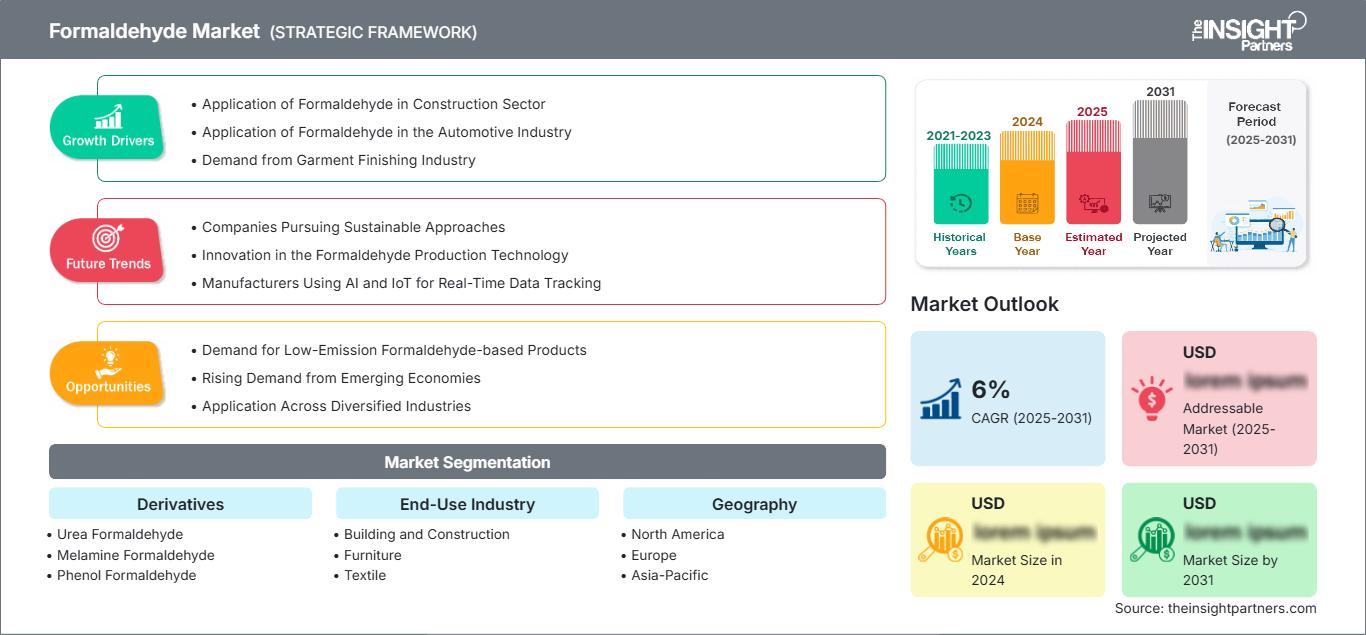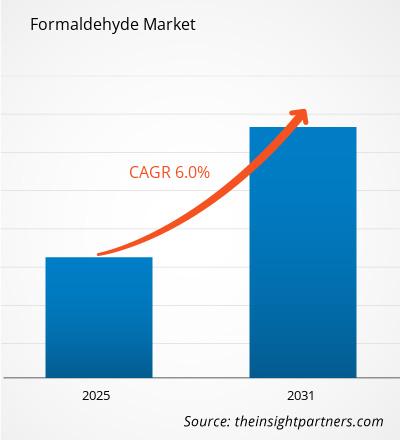Le marché du formaldéhyde devrait enregistrer un TCAC de 6 % entre 2025 et 2031, avec une taille de marché passant de XX millions de dollars américains en 2024 à XX millions de dollars américains d'ici 2031.
Le rapport est segmenté par dérivés (urée formaldéhyde, mélamine formaldéhyde, phénol formaldéhyde, pentaérythritol et autres). Le rapport présente également une analyse basée sur l'industrie d'utilisation finale (bâtiment et construction, ameublement, textile, automobile, médical, agrochimie et autres). L'analyse mondiale est ensuite ventilée au niveau régional et par principaux pays. La taille du marché et les prévisions aux niveaux mondial, régional et national pour tous les segments de marché clés sont couvertes dans le cadre du rapport. Le rapport indique la valeur en USD pour l'analyse et les segments ci-dessus. Français Le rapport fournit des statistiques clés sur l'état du marché des principaux acteurs du marché et offre des tendances et des opportunités de marché.
Objectif du rapport
Le rapport sur le marché du formaldéhyde de The Insight Partners vise à décrire le paysage actuel et la croissance future, les principaux facteurs moteurs, les défis et les opportunités. Cela fournira des informations à diverses parties prenantes commerciales, telles que :
- Fournisseurs de technologies/Fabricants : Pour comprendre la dynamique évolutive du marché et connaître les opportunités de croissance potentielles, leur permettant de prendre des décisions stratégiques éclairées.
- Investisseurs : Pour mener une analyse complète des tendances concernant le taux de croissance du marché, les projections financières du marché et les opportunités qui existent tout au long de la chaîne de valeur.
- Organismes de réglementation : Pour réglementer les politiques et les activités de police sur le marché dans le but de minimiser les abus, de préserver la confiance des investisseurs et de maintenir l'intégrité et la stabilité du marché.
Segmentation du marché des dérivés du formaldéhyde
- Urée formaldéhyde
- Mélamine formaldéhyde
- Phénol formaldéhyde
- Pentaérythritol et autres
Industrie d'utilisation finale
- Bâtiment et construction
- Ameublement
- Textile
- Automobile
- Médical
- Produits agrochimiques et autres
Vous bénéficierez d’une personnalisation sur n’importe quel rapport - gratuitement - y compris des parties de ce rapport, ou une analyse au niveau du pays, un pack de données Excel, ainsi que de profiter d’offres exceptionnelles et de réductions pour les start-ups et les universités
Marché du formaldéhyde: Perspectives stratégiques

- Obtenez les principales tendances clés du marché de ce rapport.Cet échantillon GRATUIT comprendra une analyse de données, allant des tendances du marché aux estimations et prévisions.
Facteurs de croissance du marché du formaldéhyde
- Application du formaldéhyde dans le secteur de la construction : Le secteur de la construction est l’un des principaux utilisateurs finaux de formaldéhyde, notamment dans la production de produits en bois composite, d’isolants et de produits d’étanchéité. L’augmentation du nombre de bâtiments résidentiels et commerciaux due à l’urbanisation et à la croissance démographique accroît la consommation de produits contenant du formaldéhyde. De plus, les exigences en matière de matériaux de construction augmentent en raison des exigences accrues en matière de durabilité, de résistance au feu, de fiabilité et de stabilité, ce qui explique l’utilisation répandue du formaldéhyde.
- Application du formaldéhyde dans l’industrie automobile : Le secteur automobile est également un secteur important où le formaldéhyde est utilisé dans la production de pièces telles que les composites, les adhésifs et les revêtements. La production automobile, en particulier dans les pays en développement, est également un facteur de croissance du marché du formaldéhyde. De plus, la demande croissante de matériaux légers pour améliorer le rendement énergétique et réduire les émissions stimule le marché des résines de formaldéhyde, car elles sont légères, mais solides et durables.
- Demande de l'industrie de la finition des vêtements : Le formaldéhyde est également largement utilisé dans l'industrie de la finition des vêtements pour la fabrication de tissus durables et infroissables. Avec l'évolution des goûts et des préférences des consommateurs qui se tournent vers les textiles performants, l'utilisation de finitions et de traitements contenant du formaldéhyde ne cesse d'augmenter. De plus, la demande croissante de tapis en nylon, une fibre synthétique largement liée au formaldéhyde lors des processus, stimule la croissance de ce secteur.
Tendances futures du marché du formaldéhyde
- Entreprises adoptant des approches durables : Le marché du formaldéhyde évolue à mesure que de plus en plus d'entreprises adoptent des approches durables, notamment la chimie verte. Cela implique également de choisir des formulations de résine de formaldéhyde à faibles émissions, voire nulles, ou de développer des alternatives écologiques à d'autres résines. L'évolution mondiale vers le développement durable et la quête d'une moindre dépendance aux combustibles fossiles ont également suscité un intérêt pour le développement de produits chimiques biosourcés et de ressources renouvelables dans la plupart des industries. Dans ce cas, le reste du monde utilise les technologies déjà avancées.
- Innovation dans la technologie de production de formaldéhyde : Les développements actuels des procédés de production de formaldéhyde ont permis d'améliorer concrètement le niveau de production tout en réduisant les coûts. De plus, le développement d'autres technologies, telles que l'oxydation catalytique du formaldéhyde et la conception de réacteurs avancés pour la production de formaldéhyde, a commencé à produire des résultats positifs sur la production de formaldéhyde. Ces améliorations contribuent à augmenter la production tout en réduisant les produits indésirables, favorisant ainsi des approches de production plus respectueuses de l'environnement.
- Fabricants utilisant l'IA et l'IoT pour le suivi des données en temps réel : Le fonctionnement des technologies de fabrication intelligente intégrées à l'Internet des objets (IoT) et à l'intelligence artificielle (IA) est particulièrement visible dans l'industrie du formaldéhyde. La capacité de suivre l'activité et d'analyser les informations en temps réel permet aux fabricants d'ajuster la façon dont les biens sont produits, de contrôler la qualité du produit final et la quantité de déchets produits. Les systèmes automatisés de manipulation et de traitement du formaldéhyde permettent d'améliorer la sécurité, l'efficacité et la capacité à répondre aux besoins spécifiques du marché.
Opportunités du marché du formaldéhyde
- Demande de produits à base de formaldéhyde à faibles émissions : Face à la montée des préoccupations environnementales, les fabricants se voient offrir de plus en plus de possibilités de concevoir des produits à base de formaldéhyde à faibles émissions, conformes à la réglementation et répondant aux besoins des clients en matière de produits plus sûrs. Les entreprises devraient ainsi pouvoir réorienter leurs processus de production vers des secteurs plus prometteurs et moins coûteux : la production de matériaux de construction et d'articles ménagers contenant peu ou pas de produits chimiques à base de formaldéhyde.
- Demande croissante des économies émergentes : Les économies émergentes d'Asie-Pacifique offrent des opportunités de croissance dans le cadre de la demande en forte croissance d'adhésifs pour panneaux de bois et autres produits connexes. Les entreprises peuvent envisager des fusions ou des acquisitions pour exploiter ces opportunités de croissance et de revenus en s'implantant sur ces marchés où la demande de produits à base de formaldéhyde est en hausse.
- Application à des secteurs diversifiés : De nombreux secteurs, notamment la santé, la médecine et l'agriculture, peuvent faciliter la diversification des produits à base de formaldéhyde. De telles initiatives stratégiques développent des concepts de produits nouveaux et innovants, tandis que les efforts de R&D intégrés aux universités peuvent donner naissance à de nouveaux produits façonnant des plateformes technologiques avancées.
Marché du formaldéhyde
Les tendances régionales et les facteurs influençant le marché du formaldéhyde tout au long de la période de prévision ont été analysés en détail par les analystes de The Insight Partners. Cette section aborde également les segments et la géographie du marché du formaldéhyde en Amérique du Nord, en Europe, en Asie-Pacifique, au Moyen-Orient et en Afrique, ainsi qu'en Amérique du Sud et en Amérique centrale.Portée du rapport sur le marché du formaldéhyde| Attribut de rapport | Détails |
|---|---|
| Taille du marché en 2024 | US$ XX million |
| Taille du marché par 2031 | US$ XX Million |
| TCAC mondial (2025 - 2031) | 6% |
| Données historiques | 2021-2023 |
| Période de prévision | 2025-2031 |
| Segments couverts |
By Dérivés
|
| Régions et pays couverts | Amérique du Nord
|
| Leaders du marché et profils d'entreprises clés |
|
Densité des acteurs du marché du formaldéhyde : comprendre son impact sur la dynamique des entreprises
Le marché du formaldéhyde connaît une croissance rapide, portée par une demande croissante des utilisateurs finaux, due à des facteurs tels que l'évolution des préférences des consommateurs, les avancées technologiques et une meilleure connaissance des avantages du produit. Face à cette demande croissante, les entreprises élargissent leur offre, innovent pour répondre aux besoins des consommateurs et capitalisent sur les nouvelles tendances, ce qui alimente la croissance du marché.
- Obtenez le Marché du formaldéhyde Aperçu des principaux acteurs clés
Principaux arguments de vente
- Couverture exhaustive : Le rapport couvre l’analyse exhaustive des produits, services, types et utilisateurs finaux du marché du formaldéhyde, offrant un panorama global.
- Analyse d’experts : Le rapport est élaboré à partir de la connaissance approfondie d’experts et d’analystes du secteur.
- Informations actualisées : Le rapport garantit la pertinence commerciale grâce à sa couverture des informations récentes et des tendances des données.
- Options de personnalisation : Ce rapport peut être personnalisé pour répondre aux besoins spécifiques des clients et s’adapter aux stratégies commerciales.
Le rapport de recherche sur le marché du formaldéhyde peut donc contribuer à la compréhension du marché et des perspectives de croissance. Malgré quelques préoccupations légitimes, les avantages globaux de ce rapport tendent à l’emporter sur les inconvénients.
- Analyse historique (2 ans), année de base, prévision (7 ans) avec TCAC
- Analyse PEST et SWOT
- Taille du marché Valeur / Volume - Mondial, Régional, Pays
- Industrie et paysage concurrentiel
- Ensemble de données Excel
Rapports récents
Témoignages
Raison d'acheter
- Prise de décision éclairée
- Compréhension de la dynamique du marché
- Analyse concurrentielle
- Connaissances clients
- Prévisions de marché
- Atténuation des risques
- Planification stratégique
- Justification des investissements
- Identification des marchés émergents
- Amélioration des stratégies marketing
- Amélioration de l'efficacité opérationnelle
- Alignement sur les tendances réglementaires




















 Obtenez un échantillon gratuit pour - Marché du formaldéhyde
Obtenez un échantillon gratuit pour - Marché du formaldéhyde